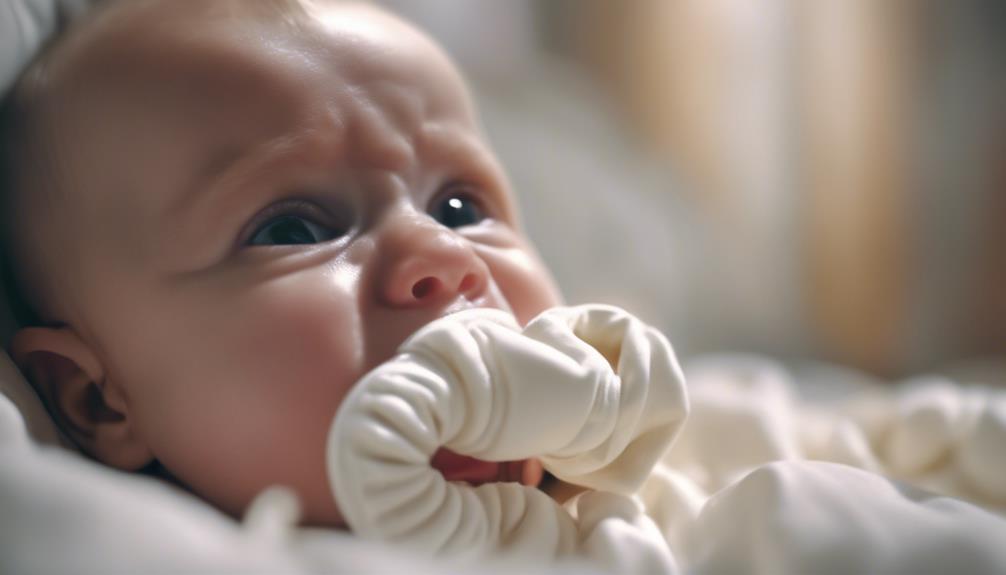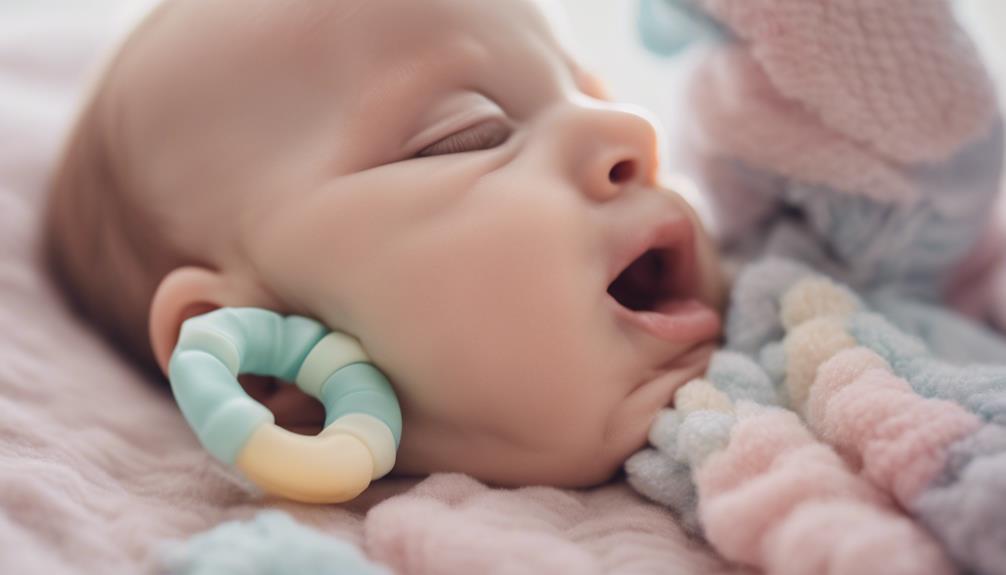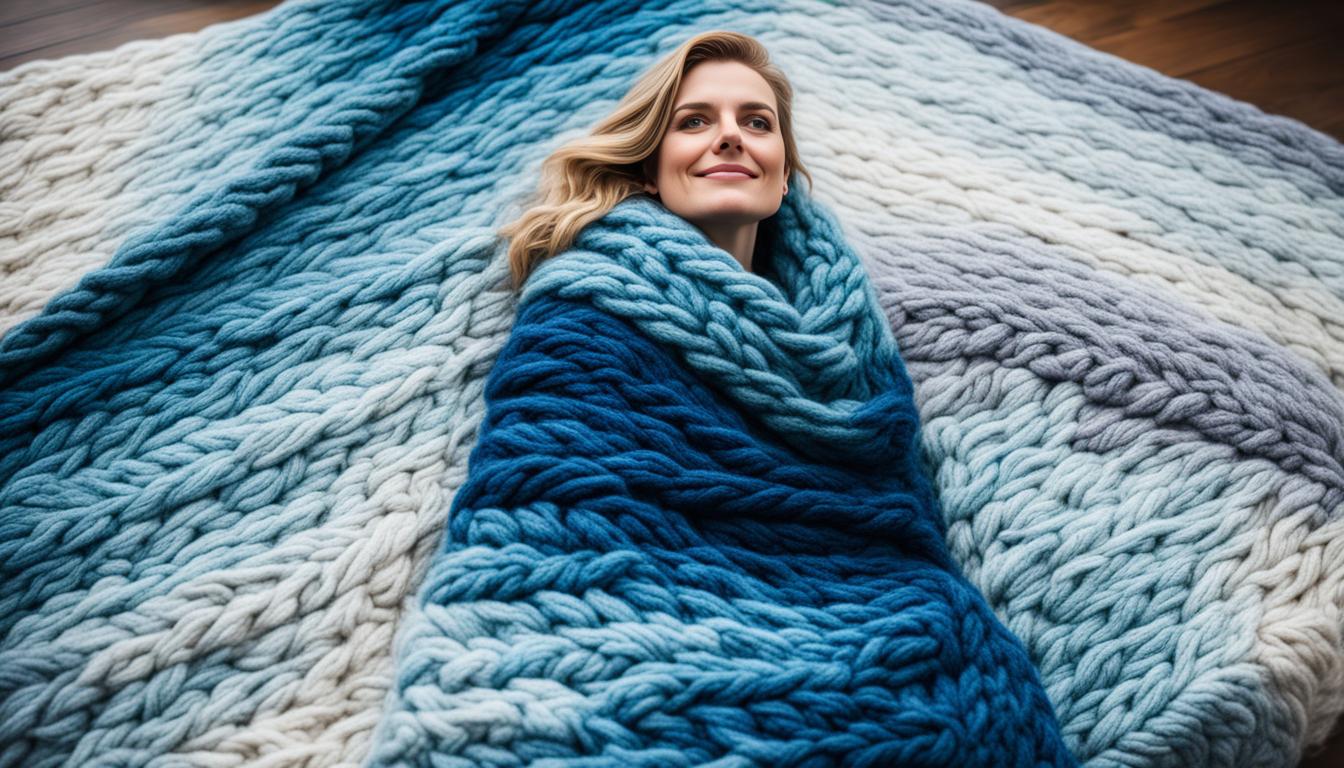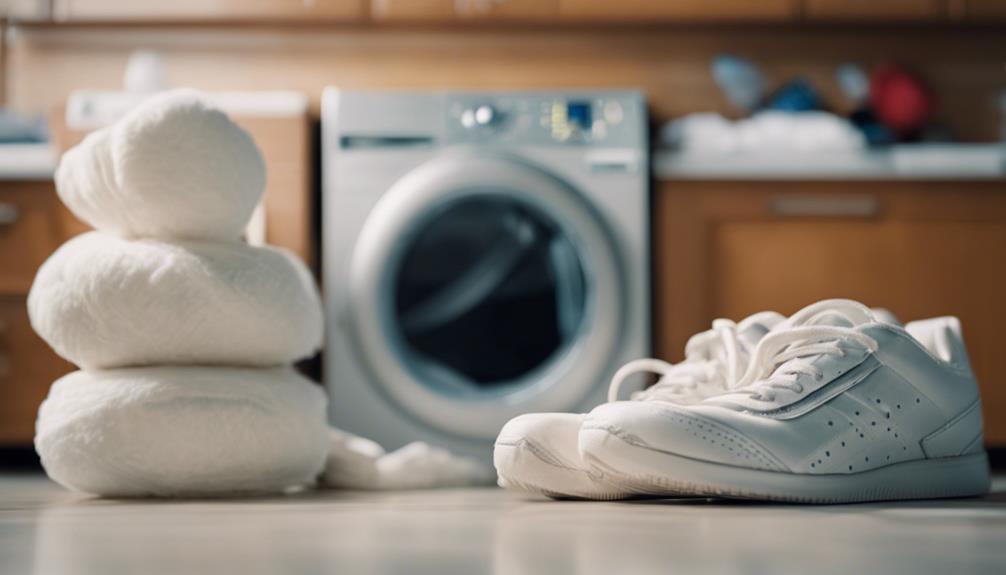We need to avoid letting our baby eat a comforter due to potential risks. The fibers or filling can pose choking hazards and lead to digestive complications. Immediate medical attention is important if ingestion is suspected. To prevent choking, guarantee secure placement and regularly check for loose threads. Opt for safe, non-toxic materials and supervise closely. Consider alternatives like clean comforters for chewing or chilled teething toys. By prioritizing safety, we can ensure our baby's well-being. Remember, their safety is our top priority, so always remain vigilant. Learn more about the risks and safety measures involved.
Key Takeaways
- Ensure comforter materials are safe and non-toxic to prevent harm.
- Supervise closely to avoid choking hazards and ingestion risks.
- Offer safe teething relief alternatives like teething toys or chilled washcloths.
- Regularly inspect comforters for wear or damage to prevent ingestion.
- Seek medical help immediately if ingestion is suspected to prevent complications.
Risks of Baby Eating Comforter

Eating a comforter poses significant risks for babies, including potential choking hazards and digestive complications. It's important to understand that comforters aren't safe for babies to ingest in any way.
Swallowing hazards arise when small parts of the comforter are consumed, which can lead to obstruction in the baby's airway or digestive tract. Choking risks are high when fibers or filling from the comforter are ingested, putting the baby in danger of suffocation.
Ingestion dangers are a serious concern, as consuming any part of the comforter can result in poisoning or other health complications for the baby. If a baby ingests any material from a comforter, immediate medical attention is necessary to prevent further harm.
Parents and caregivers must be vigilant in keeping comforters away from babies to safeguard their safety and well-being. Remember, it's always better to be cautious when it comes to items that could pose harm to little ones.
Choking Hazard Concerns

Taking precautions to prevent choking hazards is crucial when it comes to handling comforters around babies. Here are some important points to keep in mind for keeping your baby safe from choking hazards related to comforters:
- Supervision: Always closely supervise your baby when they're near a comforter to prevent them from putting it in their mouth.
- Secure Placement: Guarantee that comforters are kept out of reach during sleep and playtime to avoid any accidental ingestion.
- Inspect Regularly: Check the comforter regularly for any loose threads or filling that could potentially be a choking hazard.
- Immediate Action: If you notice your baby putting a comforter in their mouth or suspect they've ingested any part of it, seek medical help immediately to prevent any potential airway obstruction.
Harmful Fibers in Comforters

Moving on from the concerns of choking hazards associated with comforters, the presence of harmful fibers in these items can pose serious risks to a baby's health. While comforters are often seen as soft toys or comforting items for babies, it's vital to be aware of the potential dangers they may harbor.
Harmful fibers, such as polyester or synthetic materials, can lead to digestive issues, blockages, or respiratory problems if ingested by a baby. To prevent these risks, it's important to make sure that babies don't eat or chew on comforters. Opting for natural, non-toxic materials like cotton can help mitigate the dangers associated with harmful fibers in comforters.
Supervision is key when babies are around comfort items to prevent accidental ingestion of these fibers. By choosing safe materials and closely monitoring your baby's interaction with comforters, you can help create a secure environment for your little one.
Teething Relief Alternatives

When searching for ways to soothe teething discomfort in babies, it's important to explore safe alternatives that offer relief without posing any harm.
Here are some teething relief alternatives to explore:
- Clean Comforter: If your baby enjoys chewing on their comforter, make sure it's clean and free from any harmful substances that could pose a hazard.
- Chilled Teething Toys: Offering chilled teething toys can help numb your baby's gums and provide soothing relief during teething discomfort.
- Damp Washcloth: A clean, damp washcloth can also be a safe option for your baby to chew on, providing relief and comfort.
- Avoid Choking Hazards: It's crucial to steer clear of giving small or sharp objects that could potentially cause choking hazards for teething babies. Always prioritize safety when selecting teething relief options.
Supervision for Baby Safety

We must always keep a close eye on our little ones when they've their comforter to safeguard their safety.
It's important to create a safe sleep environment by removing any potential hazards.
Safe Sleep Environment
To ensure a safe sleep environment for your baby, always supervise them closely to prevent any potential hazards. When it comes to guaranteeing your baby's safety during sleep time, there are several key points to keep in mind:
- Choose Safe Comfort Items: Opt for comforters made from safe and non-toxic materials to avoid any potential harm.
- Regularly Inspect Comforter: Check the comforter regularly for wear or damage that could pose a risk of ingestion.
- Encourage Safe Alternatives: Provide your baby with teething toys or other safe items to redirect their chewing urges.
- Seek Medical Help: If you suspect your baby has ingested part of their comforter, seek immediate medical advice for proper evaluation and care.
Monitor Baby Closely
Keeping a close eye on your baby is crucial to guarantee their safety and prevent any potential hazards. Always monitor your baby closely when they're near a comforter to avoid potential choking hazards. Supervise your baby to make sure they don't try to eat or swallow any parts of the comforter.
Regularly check the comforter for wear and tear that could cause small parts to come loose and pose a choking risk. If you notice your baby attempting to put the comforter in their mouth, intervene immediately. Make sure the comforter is small, lightweight, and securely attached to prevent any ingestion risks for your baby.
Remove Hazards Promptly
Removing hazards promptly is essential for ensuring the safety of your baby. When it comes to your baby and their comforter, taking precautions is important. Here are some important steps to follow:
- Supervise your baby closely: Always keep an eye on your little one to prevent any attempts at eating or swallowing parts of the comforter.
- Regularly check the comforter: Look out for loose threads, small parts, or any hazards that could be ingested.
- Act immediately: If you see your baby trying to chew on the comforter, remove it right away to avoid choking or ingestion.
- Be mindful of attachments: Some comforters have accessories that may come loose and pose a choking hazard.
Comforter Use for Babies

Let's discuss the safety of comforters and the suitability of comforter materials for babies.
It's essential to choose a comforter made from baby-safe materials to avoid any potential harm.
Ensuring a baby-friendly design and construction can provide comfort and security without risking ingestion or choking hazards.
Safety of Comforters
When considering the safety of comforters for babies, it's important to understand that these items aren't designed for ingestion and can present choking hazards or digestive issues if swallowed. Here are some key points to keep in mind:
- Comforters are meant for safe sleep and comfort, not for consumption.
- Parents should supervise their baby's use of comforters to prevent any potential hazards.
- It's essential to avoid comforters with bean fillings or small parts that could be a choking risk.
- If a baby tries to chew on a comforter, redirect them to appropriate teething toys promptly.
Comforter Materials for Babies
For babies, selecting comforters made from safe, soft, and breathable materials like cotton is important to guarantee their comfort and safety. These materials make sure that the comforter is gentle on your baby's delicate skin and allows for proper airflow, reducing the risk of overheating.
Opting for washable comforters is also necessary for maintaining cleanliness and hygiene, as babies can be messy. Avoid comforters with small parts, loose threads, or attachments that could pose a choking hazard.
It's vital to choose lightweight and appropriately sized comforters to prevent any suffocation risks during sleep or play. Always check that the comforter material is free from harmful chemicals or dyes that could potentially harm your baby if ingested.
Comforter Introduction Guidelines

Introducing comforters to your baby involves establishing clear guidelines to guarantee their safety and comfort. When it comes to comforter introduction guidelines, here are some key points to keep in mind:
- Set boundaries: Make it clear that the comforter is for cuddling and soothing, not for eating. Establishing this early on can help prevent any confusion for your baby.
- Supervise closely: Always keep an eye on your baby when they're using a comfort object. This way, you can make sure they're using it properly and not putting it in their mouth.
- Choose wisely: Select an appropriate comforter made of safe materials that are sturdy and durable. Avoid items that can easily tear or have small parts that could be a choking hazard.
- Encourage safe sleep practices: Incorporate the comforter into your baby's bedtime routine to promote a sense of security and comfort during sleep. Remember, a comforter should enhance sleep, not pose risks.
Safety Measures for Comforters

To guarantee the safety of babies when using comforters, it's essential to establish strict guidelines and closely monitor their interactions with these items. Safety measures must be in place to make certain that comforters are safe for babies.
Comforters should be made of non-toxic materials to prevent any harm if they're chewed on or put in the mouth. It's vital to be aware that comforters can pose a choking hazard if small parts come loose. Supervision is key when babies are around comforters to prevent them from attempting to eat or chew on them.
If a baby tries to eat a comforter, it should be removed immediately, and safe alternatives for teething or comfort should be provided. Educating babies not to chew or eat their comforters can help avoid the ingestion of fibers or small components that may detach. By following these safety measures, the risk of any harm associated with comforters can be minimized.
Managing Teething Discomfort

When babies are teething, providing safe and appropriate items for teething relief becomes important to alleviate discomfort and prevent potential hazards. Here are four tips to help manage teething discomfort effectively:
- Offer Teething Toys: Providing babies with teething toys designed to be chewed on can help soothe their gums and provide relief from teething discomfort.
- Chilled Washcloths: Placing a clean washcloth in the refrigerator for a short while and then giving it to your baby to chew on can help numb the gums and reduce teething pain.
- Avoid Choking Hazards: It's essential to avoid giving babies small objects or items that could pose a choking hazard, such as pieces of a comforter or small toys.
- Monitor Chewing: Keep a close eye on your baby while they're teething to make sure they aren't ingesting fibers or parts of their comforter, which could lead to choking or other health risks.
Frequently Asked Questions
Are Comforters Safe for Babies?
Comforters can pose a choking hazard for babies if ingested. Safe sleep practices advise keeping comforters away from a baby's mouth to prevent accidents.
It's important to supervise babies around comforters to prevent any ingestion risks. If a baby tries to eat a comforter, it should be immediately removed for safety.
Always prioritize your baby's well-being and make sure their environment is free from potential hazards like comforters.
When Can You Introduce a Comforter to a Baby?
Around 7-9 months, it's safe to introduce a comforter to your baby for reassurance and comfort. Before 6 months, it's best to avoid introducing a comforter.
Supervised naps with a comforter can be allowed before 12 months. Pay attention to your baby's cues and needs when introducing a comforter for sleep.
Remember that each baby is different, so follow their lead when deciding on the right time to introduce a comforter.
Is Bedding a Risk for Sids?
Bedding poses a risk for SIDS due to potential suffocation hazards. Soft items like comforters can obstruct a baby's airway during sleep.
The safest sleep environment includes a firm mattress with a fitted sheet and no loose bedding. Babies should sleep on their backs without additional bedding to reduce the risk of SIDS.
Following safe sleep guidelines greatly decreases the risk of SIDS associated with bedding.
Is Bedding Safe for Babies?
We must prioritize safety when it comes to babies and bedding.
It's crucial to keep bedding items away from a baby's mouth to avoid any potential choking hazards.
Supervision is key in ensuring that babies don't ingest any bedding materials.
Creating a safe sleep environment involves being mindful of what goes near a baby's mouth.
Is It Safe for Young Children to Have Comforters for Sleep?
Many experts agree that it is safe for young children to have comforters for toddlers during sleep. These items can provide a sense of security and help them feel warm and cozy. However, it’s essential to ensure that the comforter is lightweight and breathable to reduce the risk of suffocation.
Conclusion
In summary, it's crucial to always supervise your baby when introducing comforters for teething relief.
While comforters can provide comfort, they pose risks of choking hazards and harmful fibers.
One example is a parent who noticed their baby chewing on a comforter and quickly intervened to prevent any potential harm.
By following safety measures and being vigilant, you can guarantee your baby's well-being while managing teething discomfort effectively.









